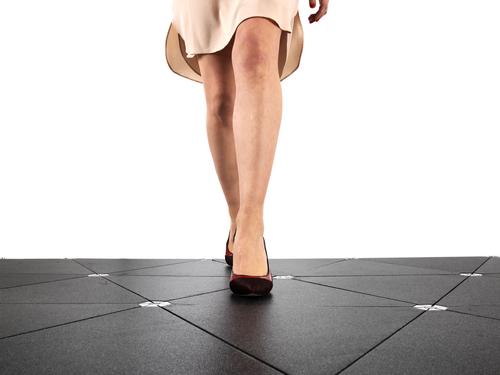These Energy-Harvesting Tiles Bank 200 Times More Power
Pavegen has significantly updated its energy-harvesting floor tile technology with improvements in its new V3 offering.
May 19, 2016
Three years ago, we told you about new floor-tile technology made from recycled tiles from a UK-based company called Pavegen that could harvest energy from the pressure of footsteps or vehicles. The company lauded the technology’s ability to help companies, governments, and other organizations become more energy efficient and provide renewable energy where and when it’s needed in a unique way.
Well fast forward three years, and the company, as they say, has come a long way, baby. Pavegen recently introduced the third generation of its floor tiles -- aptly called V3 and boasting a new design and the ability to generate 200 times more power than the original technology.
“V3 was the result of 129 prototypes, the founding of an advisory board, and recruitment of our chief technology officer [Craig Webster] who leads the engineering team in Silicon Fen, Cambridge,” Sanaa Siddiqui, Pavegen’s communications officer, told Design News in an interview. “It's sleeker than all our previous models -- comprised now of only two main components, the generator and the topsheet -- and works as a flooring system to ensure every step on the technology is captured and converted into electricity.”
Pavegen also updated the data capabilities of its floor tiles in V3 to include comprehensive analysis of consumer patterns by continuous footfall tracking and heat mapping, according to the company. V3’s built-in data technology includes a wireless API, which collates and stores data on a cloud system that can then be monitored for data analytics, or used directly as an interactive system that displays the footfall per step and energy generated, Siddiqui said.
“We've always had wireless connectivity in our tiles but the V3 has greater capabilities and captures more data through each step, helping to power online applications and even connect to social media,” she said.

The new V3 energy-harvesting floor tiles from UK-based company Pavegen, which boasts 200 times the power of the original version of the technology launched three years ago. The update to the tiles also includes expanded data capabilities and a sleeker, triangle-shaped design.
(Source: Pavegen)
Pavegen was founded in 2009 by Laurence Kemball Cook and has grown from a five-member team to one that has more than 40 staff of engineers, designers, and other technologists around the world today.
In a press statement, Cook called the launch of V3 “the biggest moment in Pavegen’s history. We’ve created a product that can reshape the way people move in our cities, and with current digitization our ability to connect physical and digital worlds through a single footstep places us at the forefront of the footfall energy harvesting market,” he said.
Pavegen has had some notable deployments since its launch. One of its earliest was to provide energy for the lighting of the West Ham tube station in London during the 2012 Olympics. Another was an installation in Terminal 3 of London’s Heathrow Airport also to power local lighting.
Since then the company also has deployed the technology to support underserved communities in poorer regions of the world. Through a partnership with gas and energy company Shell, Pavegen has installed its tiles in neighborhood soccer fields in Rio de Janeiro, Brazil, and Lagos, Nigeria, as part of Shell’s Make the Future campaign. The energy from the tiles is used in those fields to power floodlights so the soccer pitches can be used at night, as well as to provide energy for the local communities.
READ MORE ARTICLES ON ENERGY HARVESTING:
Siddiqui said this use of the technology was completely unexpected but has won positive attention for Pavegen. “When we launched the company, we weren't expecting to install our tiles beneath football pitches,” she said. “Our projects with Shell in Rio and Lagos have been the most successful to date, and have completely shaped how people perceive Pavegen.”
With the launch of V3, Pavegen now aims to shift from proof of concepts and experimental installations toward larger, permanent projects in the retail, transport, and public-space sectors, Siddiqui said. The company already has two installations in the pipeline for the new technology, she said. One will be at the Westfield Shopping Centre, the largest shopping center in Europe, and the other will be at Dupont Circle in Washington.
The company also wants to expand its data offering to support the increased and future adoption of the Internet of Things (IoT), as well as launch an online app that can monitor the number of steps and energy generated by the tiles so customers can either redeem the energy for points or donate it to areas that need it, Siddiqui said.
Elizabeth Montalbano is a freelance writer who has written about technology and culture for more than 15 years. She has lived and worked as a professional journalist in Phoenix, San Francisco and New York City. In her free time she enjoys surfing, traveling, music, yoga and cooking. She currently resides in a village on the southwest coast of Portugal.
About the Author(s)
You May Also Like

.jpg?width=300&auto=webp&quality=80&disable=upscale)

